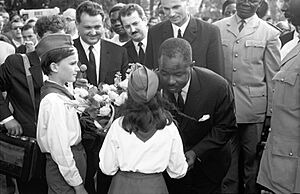Ahmadou Ahidjo facts for kids
Quick facts for kids
Ahmadou Ahidjo
|
|
|---|---|
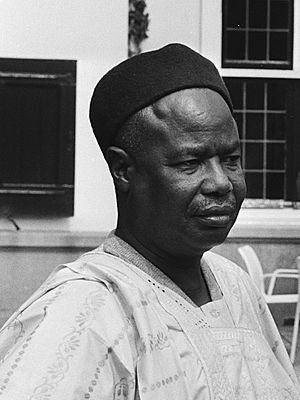
Ahidjo at the Catshuis in The Hague, 1979
|
|
| 1st President of Cameroon | |
| In office 5 May 1960 – 6 November 1982 |
|
| Vice President | John Ngu Foncha Salomon Tandeng Muna |
| Preceded by | Position established |
| Succeeded by | Paul Biya |
| 1st Prime Minister of Cameroon | |
| In office 1 January 1960 – 15 May 1960 |
|
| Preceded by | Position established |
| Succeeded by | Charles Assalé |
| Personal details | |
| Born | 24 August 1924 Garoua, French Cameroons |
| Died | 30 November 1989 (aged 65) Dakar, Senegal |
| Political party | CU (1958–1966) CNU (1966–1989) |
| Spouse | Germaine Ahidjo |
Ahmadou Babatoura Ahidjo (born August 24, 1924 – died November 30, 1989) was an important politician from Cameroon. He became the first President of Cameroon in 1960 and served until 1982.
Ahidjo played a big part in helping Cameroon gain its independence from France. He also worked to bring together the French-speaking and English-speaking parts of the country. During his time as president, he created a strong central government. In 1966, he set up a single-party system under the Cameroon National Union (CNU). Later, in 1972, he changed Cameroon from a group of states (a federation) into one united country.
Ahidjo stepped down as president in 1982. This was a surprise to many people in Cameroon. Paul Biya then became the new president. In 1984, Ahidjo was accused of planning to overthrow Biya. He was found guilty without being present for the trial and was sentenced to death. However, he died of natural causes in 1989.
Ahmadou Ahidjo's Early Life
Ahidjo was born in Garoua, a big river port city in northern Cameroon. At that time, Cameroon was a territory managed by France after World War I. His mother was from the Fulani people and had been a slave. His father was a Fulani village chief.
Ahidjo's mother raised him as a Muslim. When he was a child, he went to a Quranic school. In 1932, he started attending a local government primary school. After not passing his first school exam in 1938, Ahidjo worked for a few months helping with animal health. He went back to school and passed his exam a year later.
For the next three years, Ahidjo went to secondary school in Yaoundé, which was the capital city. He studied to prepare for a job in public service. At school, he also played soccer and was a cyclist.
In 1942, Ahidjo started working for the government as a radio operator for the postal service. His job took him to many cities across the country, like Douala and Ngaoundéré. He was one of the first government workers from northern Cameroon to work in the southern areas. This experience helped him understand the different parts of the country. It also helped him learn how to lead a country with many different groups of people.
Ahmadou Ahidjo's Political Journey
In 1946, Ahidjo began his career in politics. From 1953 to 1957, he was a member of the French Union's Assembly. He also served as the President of Cameroon's Legislative Assembly in 1957.
Later that year, he became the Deputy Prime Minister under André-Marie Mbida. In February 1958, Ahidjo became Prime Minister at 34 years old after Mbida resigned. He worked to reassure religious leaders and traditional chiefs in the north. He also brought together different groups who were worried about growing protests.
Working Towards Independence
As Prime Minister, Ahidjo wanted Cameroon to become independent. He also aimed to reunite the separate parts of the country. He worked with the French colonial government to achieve these goals. In June 1958, Ahidjo began talks with France in Paris. These talks led to France formally recognizing Cameroon's plans for independence.
Cameroon's National Assembly set January 1, 1960, as the date for independence. During this time, Ahidjo recruited people from the northern, Muslim Fulani and Peuhl groups into the army.
Challenges to Independence
Ahidjo's approach of working with France faced opposition. Some groups wanted a more revolutionary way to gain independence. They formed a political party called the Union des populations du Cameroun (UPC). This party was seen as pro-communist during the Cold War.
In March 1959, Ahidjo spoke to the United Nations. He asked for support for France's independence plan for Cameroon. The United Nations decided to end French control without new elections. Ahidjo faced a rebellion from the UPC in the 1960s. He defeated it by 1970 with help from the French military. He was given special powers to end the rebellion.
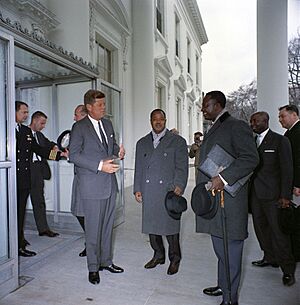
Uniting Cameroon's Regions
After the French-controlled area became independent, Ahidjo focused on reuniting it with the British-controlled area. He and his supporters wanted to integrate the two parts. They both sought a public vote (a plebiscite) for reunification. The United Nations agreed to this vote.
The vote resulted in the northern British Cameroons joining Nigeria. The southern British Cameroons voted to reunite with the rest of Cameroon. Ahidjo worked with Premier John Ngu Foncha from the English-speaking part. They worked together to bring the two parts of Cameroon together.
In July 1961, Ahidjo attended a meeting where plans for merging Cameroon were made. These plans were later approved by both assemblies. Ahidjo and Foncha met in Bamenda to create a constitution for the united country. They agreed not to join the French community or the Commonwealth of Nations.
In the summer of 1961, they finalized the constitution in Foumban. On October 1, 1961, the two separate Cameroons merged. This created the Federal Republic of Cameroon. Ahidjo became president, and Foncha became vice president.
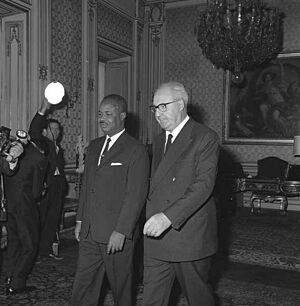
Centralizing Power
Ahidjo and Foncha disagreed on how to manage the different regions. In December 1961, Ahidjo created administrative regions. He appointed Federal Inspectors of Administration who reported directly to him. These inspectors had power over police and federal services. This led to conflicts with local leaders.
During the early years, French influence remained strong in Cameroon. French advisors helped each minister, and France kept control over many parts of Cameroon's economy. French troops stayed in the country, and many Cameroonian army officers were French.
In 1961, Ahidjo began to push for a single-party state. In March 1962, he made a rule that stopped people from criticizing his government. This rule allowed the government to imprison anyone who worked against the authorities.
In July 1962, some opposition leaders spoke out against Ahidjo's idea of a single-party state. They said it was dictatorial. These leaders were arrested and imprisoned. After this, many other opposition leaders joined Ahidjo's party.
On September 1, 1966, Ahidjo achieved his goal of a single-party state. The Cameroon National Union (CNU) was formed. Ahidjo said this was important for Cameroon's unity. To be elected to the National Assembly, people had to be members of the CNU. As the head of the party, Ahidjo approved all candidates. These candidates then approved all of his laws.
The government made many rules that limited people's freedoms. These included longer police detentions and banning public meetings. Publications were censored, and people's movement was restricted. Trade unions were not allowed to collect money. Anyone accused of "harming public safety" could not have a lawyer. They also could not appeal their judgment.

Ahidjo blamed Cameroon's federal structure for its slow development. He also said it caused problems between the English-speaking and French-speaking parts. His government argued that managing separate governments was too expensive for a poor country.
On May 6, 1972, Ahidjo announced he wanted to get rid of the federation. He proposed a single, united state if people supported it in a vote on May 20, 1972. This event was called "The Glorious Revolution of May Twentieth." Because Ahidjo controlled the CNU, he was sure to get the party's support.
On June 2, 1972, Ahidjo officially created the United Republic of Cameroon. This abolished the federation. A new constitution was adopted that year. It removed the position of Vice President, which gave Ahidjo even more power. Ahidjo was in charge of the state, the government, and the military.
In 1975, Ahidjo created the position of Prime Minister, which Paul Biya filled. In 1979, Ahidjo changed the constitution to make the Prime Minister his successor. Many English-speaking Cameroonians were unhappy with these changes.

In 1972, Cameroon hosted the Africa Cup of Nations soccer tournament. Ahidjo ordered the building of two new stadiums. These were the Ahmadou Ahidjo Stadium and the Unification Stadium. The Unification Stadium was named to celebrate the country becoming the United Republic of Cameroon.
Cameroon started producing oil in 1977. The government managed oil money secretly, claiming to save it for hard times. Billions of dollars were moved to accounts in Paris, Switzerland, and New York. This money was used by oil companies and government officials. France and its 9,000 citizens in Cameroon still had a lot of influence. They controlled many key parts of Cameroon's economy and banking system.
Even though some of his actions were dictatorial, Cameroon became one of the most stable countries in Africa. Ahidjo was seen as more traditional and less flashy than other African leaders. However, his policies helped Cameroon become relatively wealthy. People around Ahidjo often called him the "father of the nation."
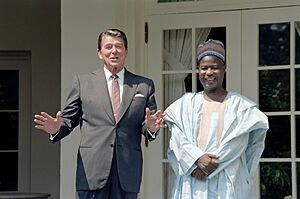
Ahidjo presented himself as the father of the nation. He had many titles, and after visiting Mecca, he was called "El Hadj." He often used the radio to speak to the country. He also announced changes in government jobs regularly. Ahidjo built a system where he gave out government resources. This helped him keep control over the diverse country. When Cameroon started earning oil money, the president controlled these funds. People got jobs, licenses, and projects from Ahidjo in exchange for their loyalty.
During Ahidjo's presidency, music helped promote national unity. Musicians wrote songs about independence, unity, and Ahidjo as the nation's father. On holidays, schools would compete by writing patriotic songs for Ahidjo. Songs that criticized politicians were rare. Musicians like Medzo Me Nsom encouraged people to vote for Ahidjo.
After the Presidency
Ahidjo resigned on November 4, 1982, saying it was for health reasons. Paul Biya, who was the Prime Minister, took over two days later. It was surprising that Ahidjo chose Biya, a Christian from the south, instead of a Muslim from the north like himself.
Ahidjo's exact plans were not clear. He might have intended to return to the presidency later. Or he might have wanted Maigari Bello Bouba, another Muslim from the north, to become president eventually. The ruling party asked Ahidjo to stay president, but he refused. However, he agreed to remain the head of the CNU party. He also arranged for Biya to become the CNU Vice-President.
For the first few months, Biya and Ahidjo worked together. In January 1982, Ahidjo removed some CNU members who did not support Biya. Both Ahidjo and Biya traveled around Cameroon to address public concerns.
Later that year, a big disagreement started between Ahidjo and Biya. On July 19, 1983, Ahidjo went to live in France. Biya then started removing Ahidjo's supporters from power. He also removed symbols of Ahidjo's authority, like his official photos. Ahidjo's name was also removed from the CNU party anthem.
On August 22, Biya announced that a plot, supposedly involving Ahidjo, had been discovered. Ahidjo strongly criticized Biya, saying he was misusing his power. Ahidjo claimed Biya feared plots and was a threat to national unity. The two leaders could not make up, even with help from other foreign leaders. Ahidjo announced on August 27 that he was resigning as head of the CNU.
While in exile, Ahidjo was found guilty in February 1984 of being involved in a plot from June 1983. He was sentenced to death in his absence, but Biya changed the sentence to life in prison. Ahidjo denied being involved in the plot. A violent but unsuccessful attempt to overthrow the government in April 1984 was also widely believed to have been planned by Ahidjo.
In his final years, Ahidjo lived between France and Senegal. He died of a heart attack in Dakar on November 30, 1989, and was buried there. A law in December 1991 officially cleared his name. On October 30, 2007, Biya said that returning Ahidjo's remains to Cameroon was "a family affair." An agreement to return his remains was made in June 2009, but as of 2021, Ahidjo remains buried in Dakar with his wife.
See also
 In Spanish: Ahmadou Ahidjo para niños
In Spanish: Ahmadou Ahidjo para niños


